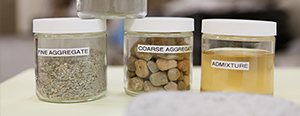Category
- Concrete Best Practices
Concrete structures are meant to last a “lifetime”. Most concrete structures have a design life of 50 or 100 years. But unfortunately we are finding that many of today’s structures are not living up to expectations. The premature deterioration of concrete infrastructure is one of the great hidden costs of our time.
It is rightly said that everything bad that happens to concrete happens as a result of water. Water carries chemical contaminants into the concrete, it can erode the surface, corrode the steel reinforcement, contribute to expansive and disruptive reactions and more.
You will want to do everything you can to keep water out of you concrete and to enhance the durability of your concrete and here are five suggestions:
 1. Mix Design
1. Mix Design
Durability starts with a concrete mix design that is properly matched to the service conditions that the concrete will be exposed to. No single mix design can be durable in every situation. For example, when concrete is exposed to sulphate contaminated soil, the mix design should consider using sulphate resistant cement. However this mix
design is not appropriate when a concrete structure is exposed to the cycles of freezing and thawing in a wet environment.
In this case, the mix design should include an air-entraining admixture since entrained air will help to protect the concrete under these conditions. The Portland Cement Association publishes Design and Control of Concrete Mixtures, which contains an excellent guide to concrete mix design.
 2. Construction Joints
2. Construction Joints
Construction joints in a concrete structure are unavoidable. They are also a common weak point in the structure where water will often find its way in and through. Water penetrating through joints can deteriorate your structure in a variety of ways, but most notably by causing corrosion of the reinforcing steel. Be sure to design your structure with adequate, pre-determined control joint locations in order to avoid random cracking. Cracks in concrete are just unplanned joints that the concrete makes for itself. Next, be sure that each joint employs a reliable waterproofing system of its own.
A joint waterproofing system that includes crystalline technology can provide the best long-term protection at joint locations. Note that crystalline technology can also self-seal random cracking and thus provide added reliability and protection.
 3. Low Permeability
3. Low Permeability
Even though mix designs must change to match the conditions, there is one factor that is common to all good concrete and that is low permeability. It is essential that water is kept out of your concrete structure. Lower permeability through good mix proportioning and by reducing the amount of free water in your mix using
water reducing admixtures or plasticizers.
Concrete that is exposed to water should also employ a waterproofing system. A crystalline waterproofing admixture such as Kryton’s Krystol Internal Membrane (KIM) has proven to be most effective at protecting concrete from water intrusion.
 4. Proper Curing
4. Proper Curing
Probably the most often overlooked step in achieving durable concrete is proper curing. Curing means maintaining conditions that will allow the concrete to harden and gain strength optimally. Proper temperature and humidity are most important. The temperature should be above 10°C for strength development to proceed at a reasonable pace. Moisture must be maintained, especially in the first few days in order to promote cement hydration and keep the concrete from drying, shrinking and cracking. Properly curing your concrete will effectively pay for itself many times over by reducing permeability and increasing the concrete’s durability and life expectancy. ACI 308R-01: Guide to Curing Concrete provides appropriate guidance.
 5. Concrete Placement
5. Concrete Placement
Concrete must be placed properly. The workability and consistency of the concrete mix must be sufficient to
place and consolidate the concrete into a solid mass that is free from any voids or rock pockets. Voids most commonly occur below or behind reinforcing steel bars – especially in areas where there are many bars together.
A dedication to proper vibration practices is the key to success here. Be sure to properly vibrate all concrete with special attention around congested reinforcement. Rock pockets are areas where there is not enough
cement paste and fine aggregate to close the space between large aggregate. Make sure there is no standing
water prior to concrete placement and do not move concrete large distance from where it is intitialy poured. The use of self-consolidating concrete can alleviate many of these concerns.
Creating durable concrete is a process. With proper mix design, permeability reduction, and attention to good jointing, placing and curing practices, one can create durable concrete structures that will resist the development of corrosive conditions and other deteriorating mechanisms.
Missing even one of these steps can seriously compromise your efforts. To learn more about how to build concrete structures that will outlive their intended design life talk to the experts at Kryton.









